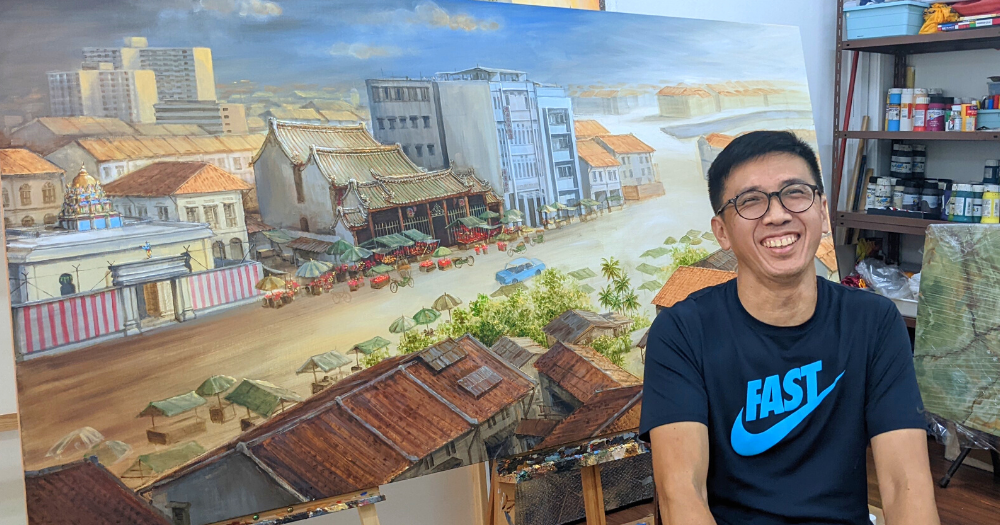The staticky hum of an old tungsten bulb, the smokey scent wafting from the woks of streetside hawkers, the clear shouts of said hawkers touting their wares mingling with the bustle of people crowded in a street too narrow and cloistered — these are some of the sensations Singaporean artist Yip Yew Chong hopes come to the minds of the people who view his paintings of a bygone Singapore.
Having grown up in a shophouse in Chinatown alongside coolie tenants, 53-year-old Yip draws on a wealth of fond memories as inspiration for his semi-realistic artworks.
If you've come across any of his paintings, or his visible wall murals scattered around heritage areas like Tiong Bahru, Chinatown and Kampong Glam, you'll notice his fascination with the past.
Yip's subjects range from olden day letter writers, street barbers to opera singers; sights and professions which, for the most part, have faded into obsolescence in modern Singapore.
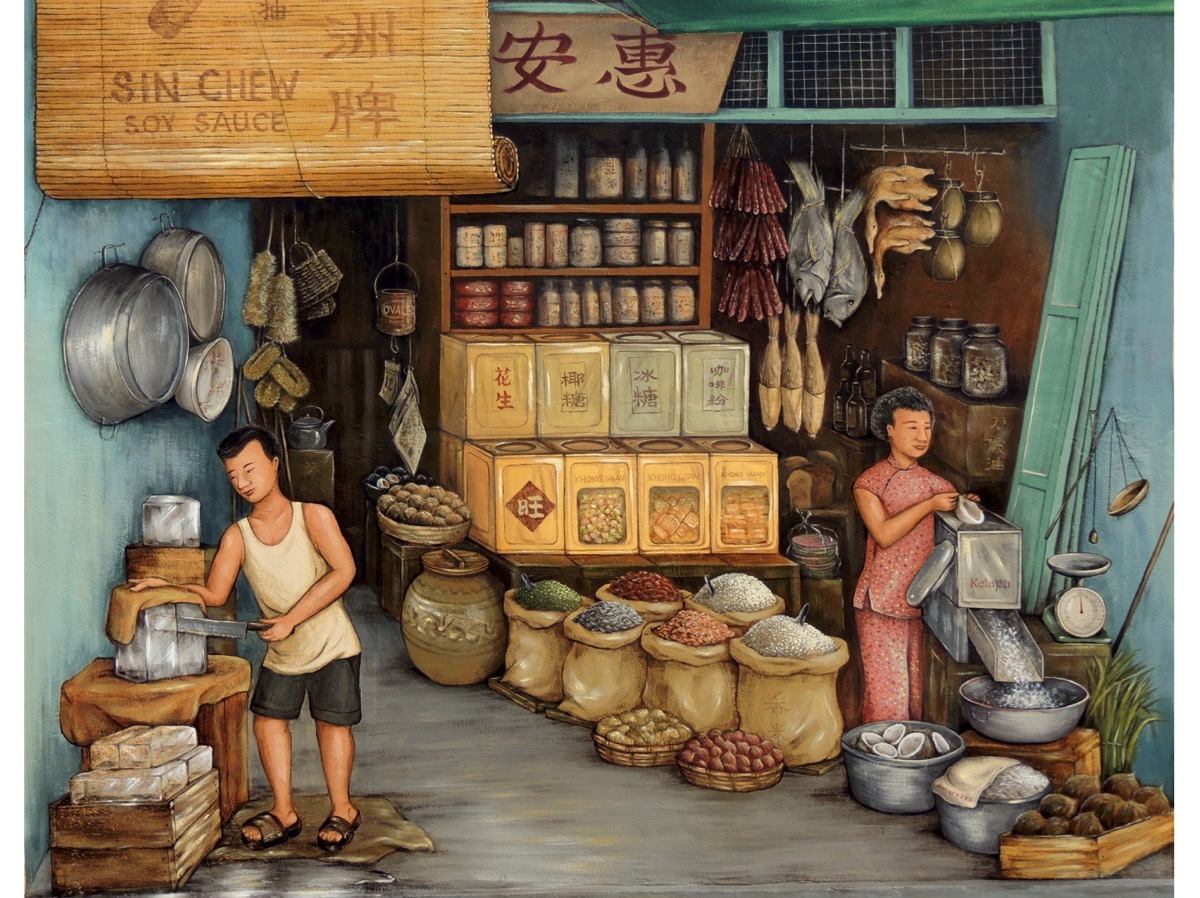 Photo from Yip Yew Chong's website
Photo from Yip Yew Chong's website
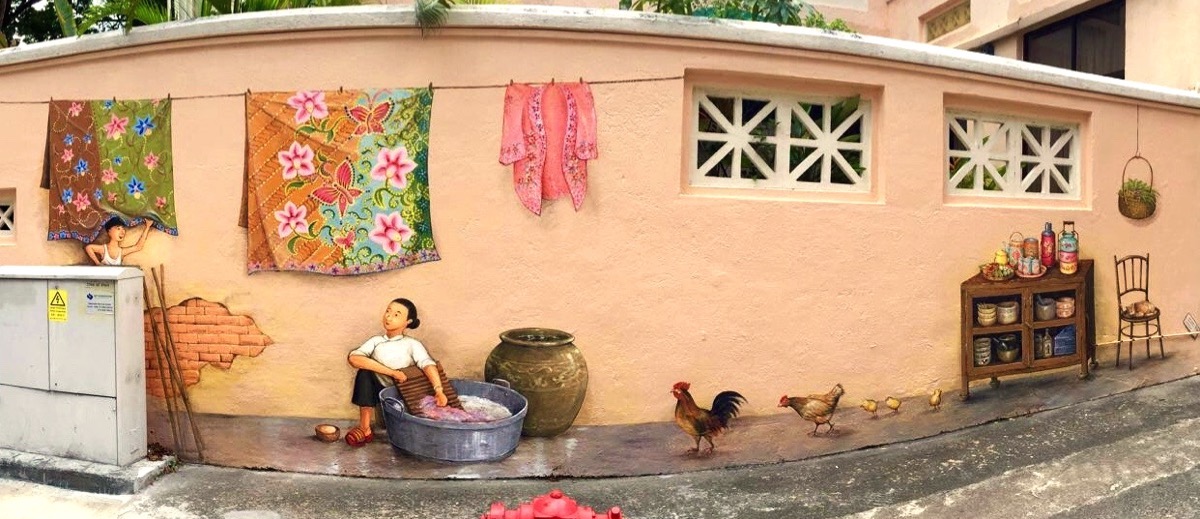 Photo from Yip Yew Chong's website
Photo from Yip Yew Chong's website
“I've seen all these old Singapore scenes a lot, that's why most of my paintings are about old Singapore," Yip says.
"Also because I'm old you know," he tacks on. "You feel a bit nostalgic when you're at this certain age."
Ditched his finance job after 25 years
With how proficient of an artist Yip appears to be, one might be surprised to learn that he previously held a job in the finance sector for 25 years.
The last time Mothership spoke with Yip was in 2017 — then, he was dressed in a collared shirt and slacks, and had taken time out of his lunch break to share about his interest in art, which started at a young age, and his lack of formal training.
Back then, art was still a part-time gig for Yip, who was working as an accountant.
Fast forward five years, and we meet Yip at his modest studio for this interview, where he's dressed casually in a shirt and shorts.
After so many years as an accountant, he has, in his words, fulfilled a large part of his "obligation" to his family.
However, it was Yip's wife who urged him to take the leap of faith in 2018 to quit his stable financial job and become a full-time artist, after observing how he struggled to juggle his full-time job and his side passion for three years, something which was "very challenging".
"She kept asking me, 'When are you going to resign?'" he laughs.
This transition was something he saw coming.
"I kind of sensed that it may come one day (becoming a full-time artist). Because of the number of years I've already worked in finance. And [from] 2015 to 2018 that period, I can also feel my art gaining traction in terms of people recognising it."
Rather importantly, being an artist is financially viable for him as well, no matter what detractors or Asian tiger mums might think, and this factored into his decision to change professions.
When asked exactly how viable being an artist is, Yip says succinctly, that it's "comparable" to his previous job.
"Comparable or better?"
"Comparable," Yip enigmatically maintains with a hearty laugh.
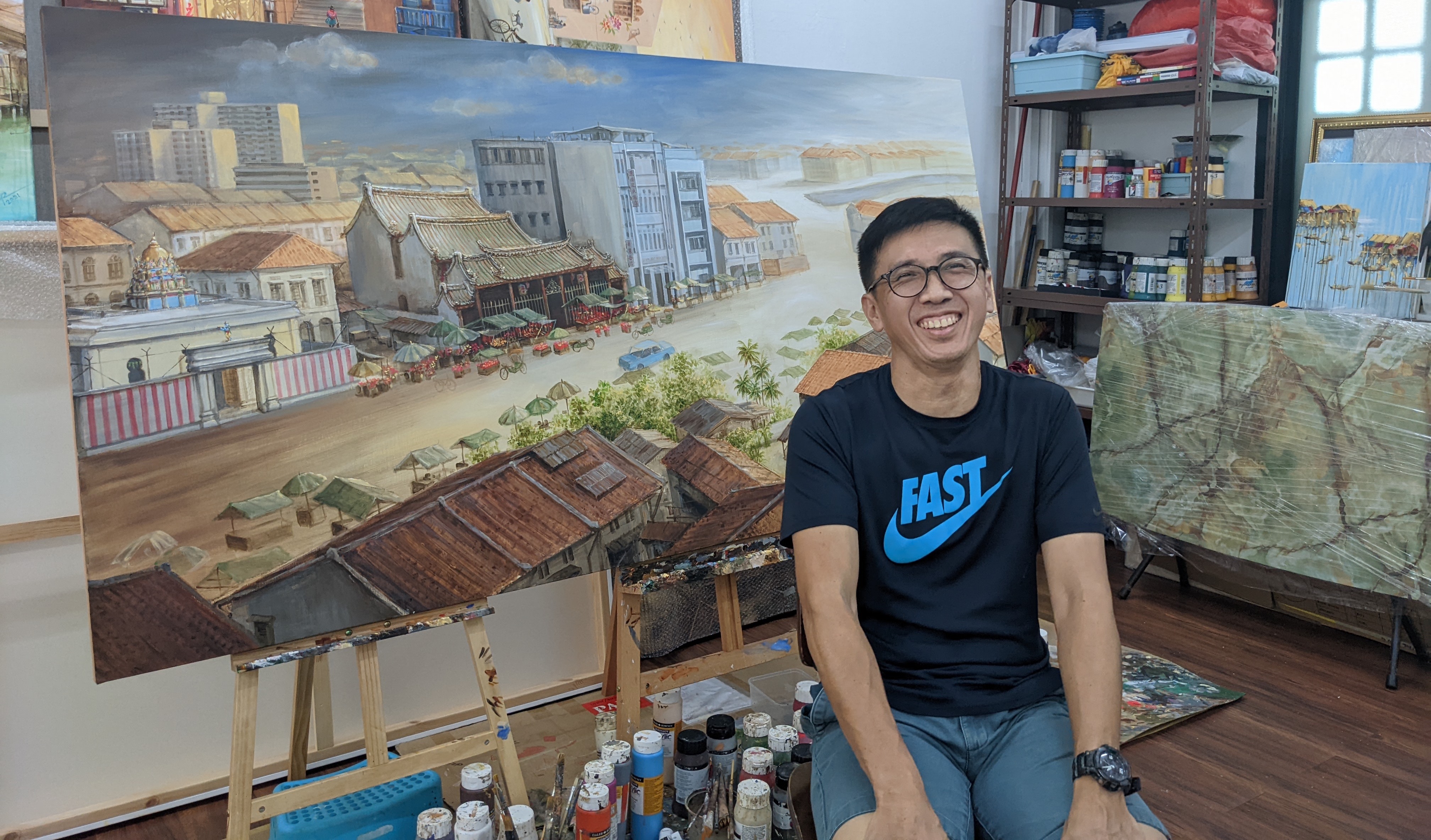 Photo by Kow Zishan
Photo by Kow Zishan
Nevertheless, Yip says it wasn't an easy decision to make, as he did enjoy his finance job, and admits that he does miss the "dynamism" of accountancy and being able to work on projects with others.
"This is more lonely," Yip says of being an artist. However, the creation process is also more meditative, something which he appreciates.
"'Lonely' is not a bad word."
Gaining fame
Now that he is able to focus on art full-time, more murals and art installations — like this one of a grouchy cat, and this roving one of several ducks and chickens — have sprouted up. Yip has even managed to hold two exhibitions in 2021.
Photos of his murals are often posted to social media, with passers-by gamely posing with the painted objects and figures.
As famous as he's been getting though — crowds gather when he is in the midst of painting a mural — Yip is still nonplussed by the attention, and prefers to maintain some semblance of anonymity.
As passionate as he is, Yip is driven by pragmatism."I find it strange also, and I also don't want to identify myself [as the artist]."
Unlike most artists who produce pieces with the intention of having the viewer leave with certain new takeaways and interpretations, Yip's sole reason for painting is simple and uncomplicated.
"I just enjoy it," he said matter-of-factly. Nothing more and nothing less.
As someone who received six years of formal education in visual arts, Yip's candidness is a breath of fresh air.
I attempt to dig deeper into his inexplicable zeal for painting — after all, I'm someone who has foregone the arts in favour of pursuing a more conventional career, the direct opposite of Yip — and instead, he throws back a question about my hobbies and why I like them.
I flounder before he slowly acquiesces with an answer:
"Because... I can see over time I'm also improving, then you feel happy that you're improving. Because the more you do, the better you feel. And even if you're not improving, when you are painting something, you're drawing something, every stroke is cumulative. And then it comes out to be a picture. When you look at that whole picture, it's like a 'mission accomplished', that kind of satisfaction."
This feeling of satisfaction is what drives him onwards.
Putting together a 50m painting of S'pore
In fact, the big project Yip has recently embarked on is an ambitious 50m painting.
The painting will comprise 23 connected canvas panels and, just to give you a sense of its scale, will be the length of an Olympic-sized swimming pool once it's completed.
It is his biggest canvas painting by far, and he plans to complete it within a year, by August 2022.
"Some people said: 'Are you mad?'"
Yip, however, is dead serious. He even shared that the painting might extend beyond 50m, if he gets more ideas on what to paint.
Inspiration struck for Yip when a friend sent him a picture of a Chinese painting, which reminded him of the famous 5.25m-long Song dynasty painting, "Along the River During the Qingming Festival".
Here's a snippet of it.
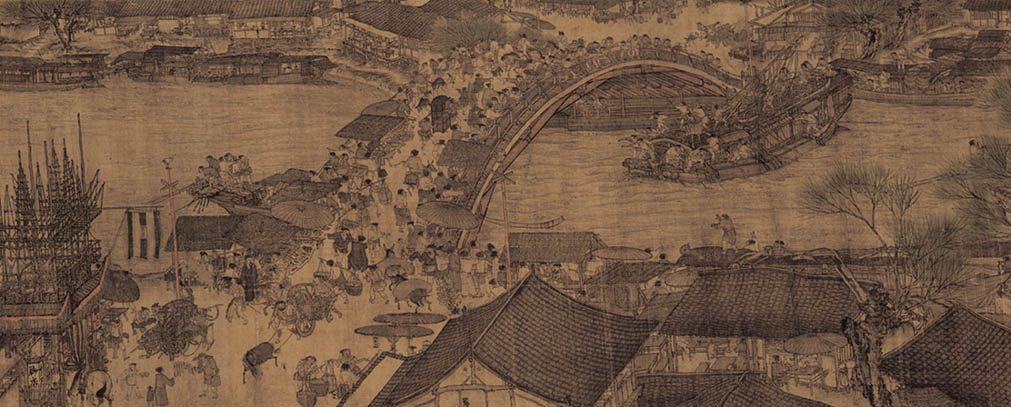 "Along the River During the Qingming Festival". Photo from Wikipedia
"Along the River During the Qingming Festival". Photo from Wikipedia
With his mind set on creating a something similar in a local context, Yip decided that his painting will reflect an amalgamation of scenes in Singapore from the 1970s and 1980s.
These two specific decades were chosen as it was time of change, both for the nation and for him.
These were Yip's growing up years, and it was also the period during which Singapore was undergoing extensive development.
The massive clean-up of the Singapore River, which heralded the revitalisation of the surrounding area, took place between 1977 and 1987.
Kampungs also made way for the proliferation of HDBs, leading to an eclectic mishmash of the old and new.
Memories on canvas
Yip and his family moved out of their Chinatown shophouse to a HDB flat in 1983, and his memories of the cramped place and the surrounding bustle were the first he transferred onto canvas.
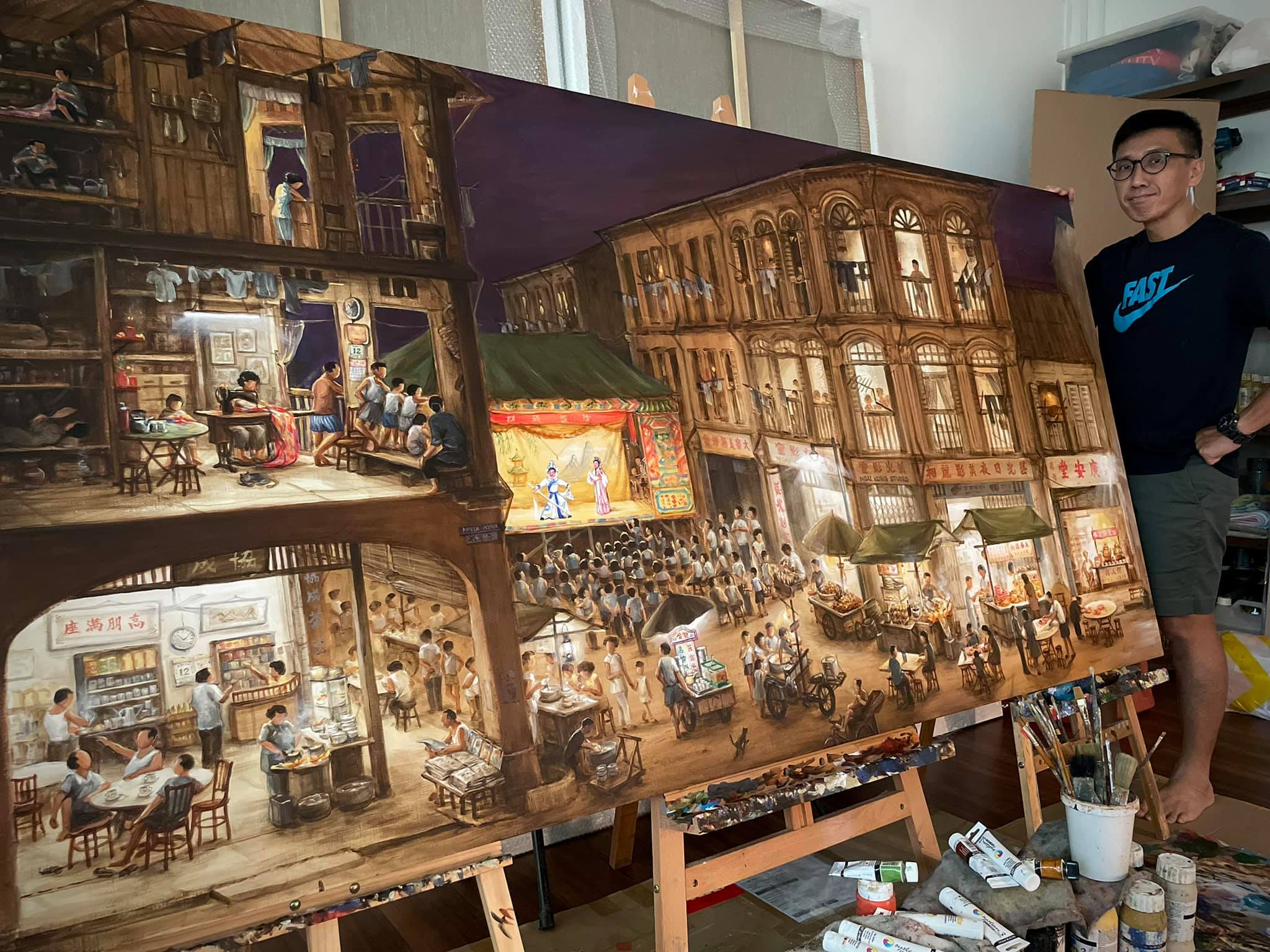 Photo from Yip Yew Chong / FB
Photo from Yip Yew Chong / FB
The 2m panel is rich with vivid detail — cue tiny traditional Kopitiam cups and saucers, ice cream uncles, traditional Chinese calendars, people decked out in Chinese opera costumes, and a cat.
Fun fact: There are recurring characters that appear across different panels, such as cats, and a Sikh man on a bicycle.
 Photo by Ashley Tan
Photo by Ashley Tan
Yip revealed that he even inserted his family and himself into the painting, and the shophouse on the left of the panel was modelled after the same one he lived in as a child. Yip himself is one of the children on the right below.
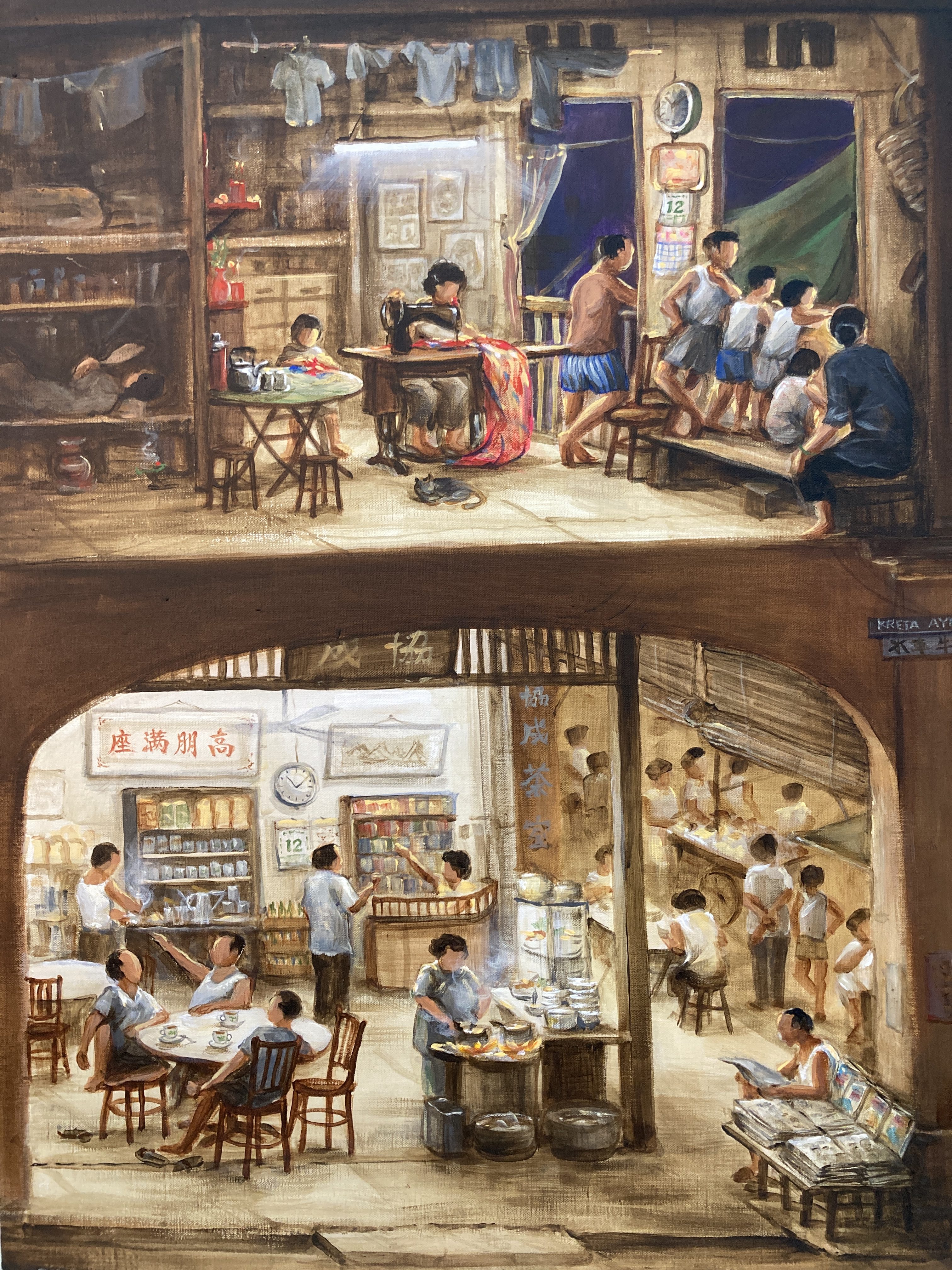 Photo by Ashley Tan
Photo by Ashley Tan
Yip's preference for painting scenes depicting everyday and ordinary life in Singapore stems from the fact that these are personal experiences he has some connection with.
Despite his art originating mostly from his own lived experiences, the sensations it invokes in viewers is universal, judging from people's reactions.
Some have shared their own memories of the past, while prints of his art displayed in nursing homes have brought tears of nostalgia to the eyes of elderly there.
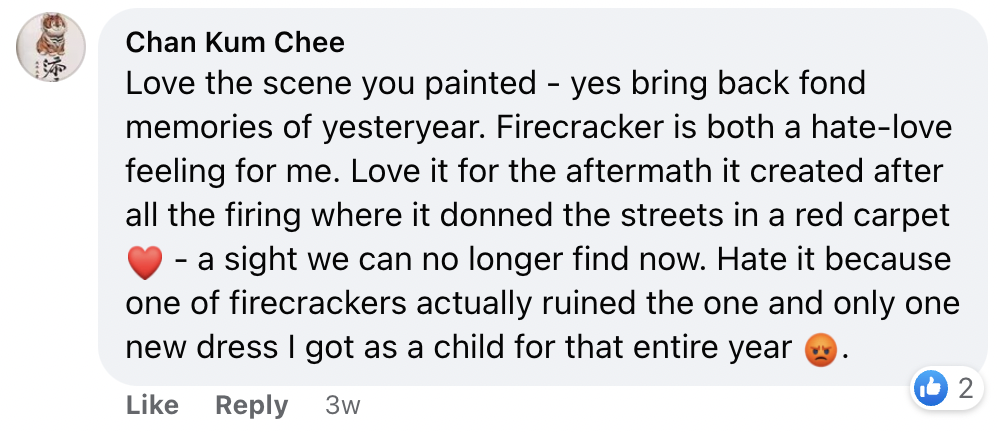

These reactions still "surprise" and "amaze" Yip, he confesses.
"So it's not about the physical form [of the art], but I think the story behind it that connects [with people]."
Imaginary but real enough
While Yip might have a vague idea of the historical elements he wants to include in his paintings, no one's memory is perfect.
Ensuring all the details are accurate in each painting is also a tedious process.
He has Googled and scrutinised hundreds of old photos, and reached out to strangers on social media to ask them to share stories or describe more details about specific buildings or places.
It is important to note though, that despite the very real buildings and elements Yip includes, the 50m painting is "fully imaginary".
For example, the buildings and temples at Waterloo Street, as pictured below, are not arranged in this exact position in real life, while the HDBs in the background actually face another direction.
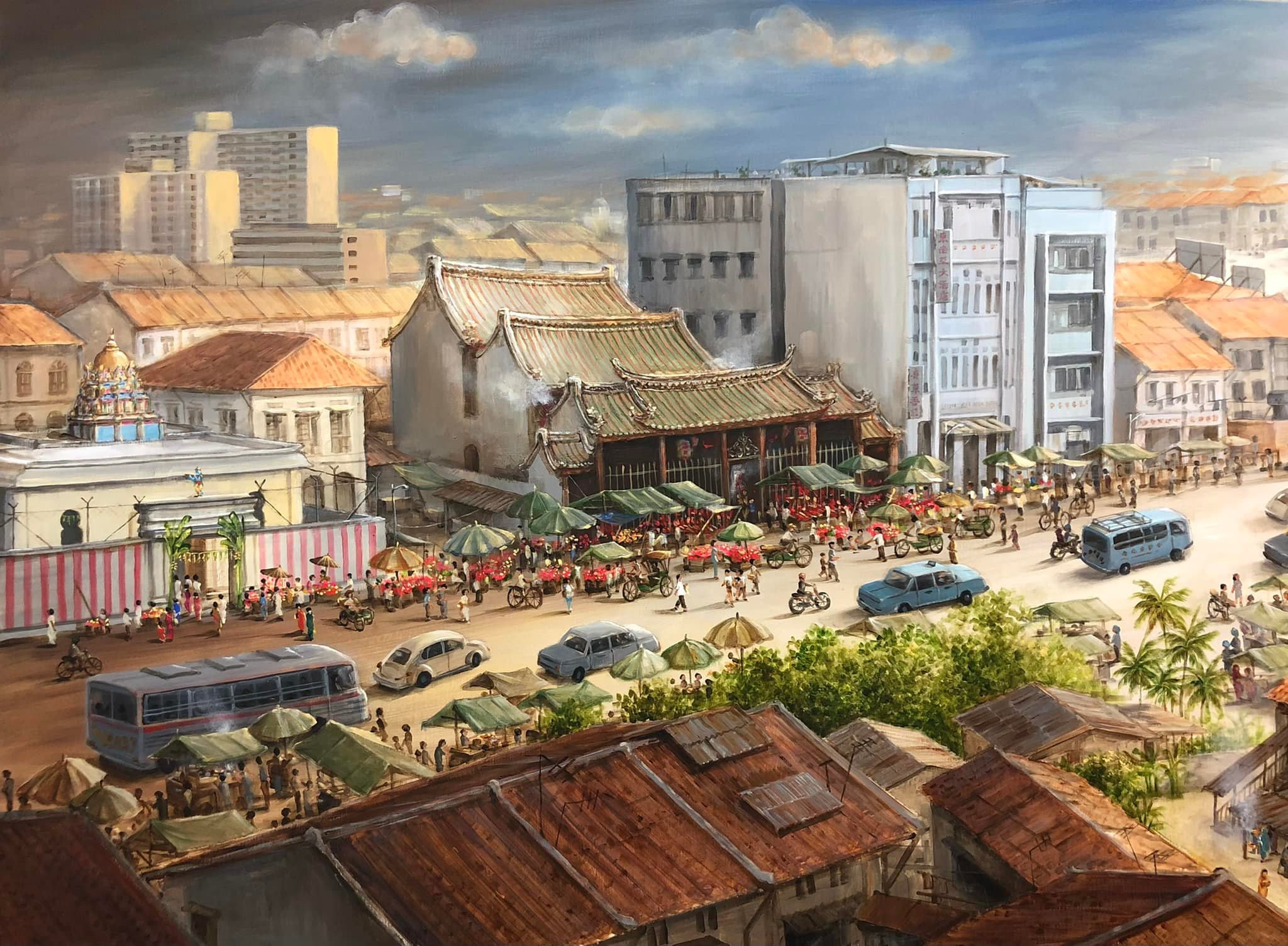 Photo from Yip Yew Chong / FB
Photo from Yip Yew Chong / FB
Yip jokes that he uses his "artistic license" to tweak reality. He quips:
"Historians will hate me. 'Oh it's not like this', [they will say]. Of course it's not like this!"
Yip isn't trying to create a replica that's completely historically accurate. Instead, he tries to capture the location's likeness and recreate the ambience of the place.
The scenes might be imaginary, but the sensations and memories it brings forth in viewers are real enough that they are able to connect emotionally with the piece. "It is imaginary, but it reflects real life," Yip says.
Not preserving heritage
Yip gave me a peek of the other panels he has completed thus far, which includes Bras Basah, Kampong Lorong Fatimah, and Toa Payoh, among others.
 Photo by Ashley Tan
Photo by Ashley Tan
 Photo by Ashley Tan
Photo by Ashley Tan
 Photo by Ashley Tan
Photo by Ashley Tan
He is fond of embedding small Easter eggs inside each painting, turning each one into a version of "Where's Waldo?".
 Photo by Ashley Tan
Photo by Ashley Tan
Pointing at a tiny figure of a man holding a bouquet of flowers, Yip asks me to find the girlfriend. I examine the daubs of paint before gesturing at a woman looking at her watch.
Bingo.
 Photo by Ashley Tan
Photo by Ashley Tan
In another painting, I notice a small glass tank of terrapins, to which Yip reacts with amazement, saying he had not expected anyone to spot it. Zoom in to try and spot it if you can.
 Photo by Ashley Tan
Photo by Ashley Tan
These details bring life to the painting, making the entire experience of viewing the 50m canvas almost like a game or illustrated book of sorts.
Simply viewing these panels is akin to taking a step back in time and walking through the yesteryear of Singapore.
For Yip, this project is something close to heart, which he believes is "very meaningful", as he has personally never seen such a large painting with so many details of old Singapore.
And although many might believe that Yip is attempting to preserve these slices of Singapore heritage, he begs to differ. Once again, his pragmatic mindset bleeds through in his answer:
"I'm not preserving history or heritage. Many of these scenes are gone already, what's there to preserve?"
There is no agenda or specific message Yip wants to convey through his paintings — rather the enjoyment viewers derive from his works, and the interest in Singapore history it promotes, are unexpected, but definitely welcome, by-products.
"It's not that I want to paint it to show young people [what Singapore was like]... that's too novel already.
I don't think any artist will say it is the original intention to create a piece of art to [convey a message]. I think most artists, because they are artists, they have to find their own satisfaction painting something.
And then secondly, money."
Being remembered
It is critical for an artist to gain recognition in order to make a living, but for Yip, it provides the fuel for him to continue to create.
"If you create art, and nobody sees it, nobody recognise it. How to survive? Where's the motivation? Yeah. So it's not that I want people to recognise me, it's just how art works. Not just commercially, but the motivations. If I just paint inside this studio, and just keep it here, if I don't expose it on social media, who's gonna see it? Where am I going to be motivated to create more and more meaningful work? The creation is for people to see it, to enjoy."
After he completes the 50m painting, Yip has thoughts of making prints of his artwork, compiling them into a book, or even digitising them or converting them into NFTs (non-fungible tokens).
"If I dont take the opportunity right, then people will forget you," he adds.
Yip eventually reveals that one of the reasons for starting this 50m painting is that he is getting bored with painting murals.
"Because these are things that if you overdo, also get bored. I get bored, people see also get bored. Why I tried to cut down... I tried to limit myself, I turned down many murals because I want to focus [on this painting] first.
There's only one Yip Yew Chong."
I disagree though. I don't believe people will find Yip's art tiresome.
As much as Yip might be blasé about his works and his motivations, perhaps he is a storyteller at heart, be it stories sourced from memories from him, others, or the collective nation.
And there will always be stories to tell.
Said Yip:
"I have all these dreams. I haven't done anything yet."
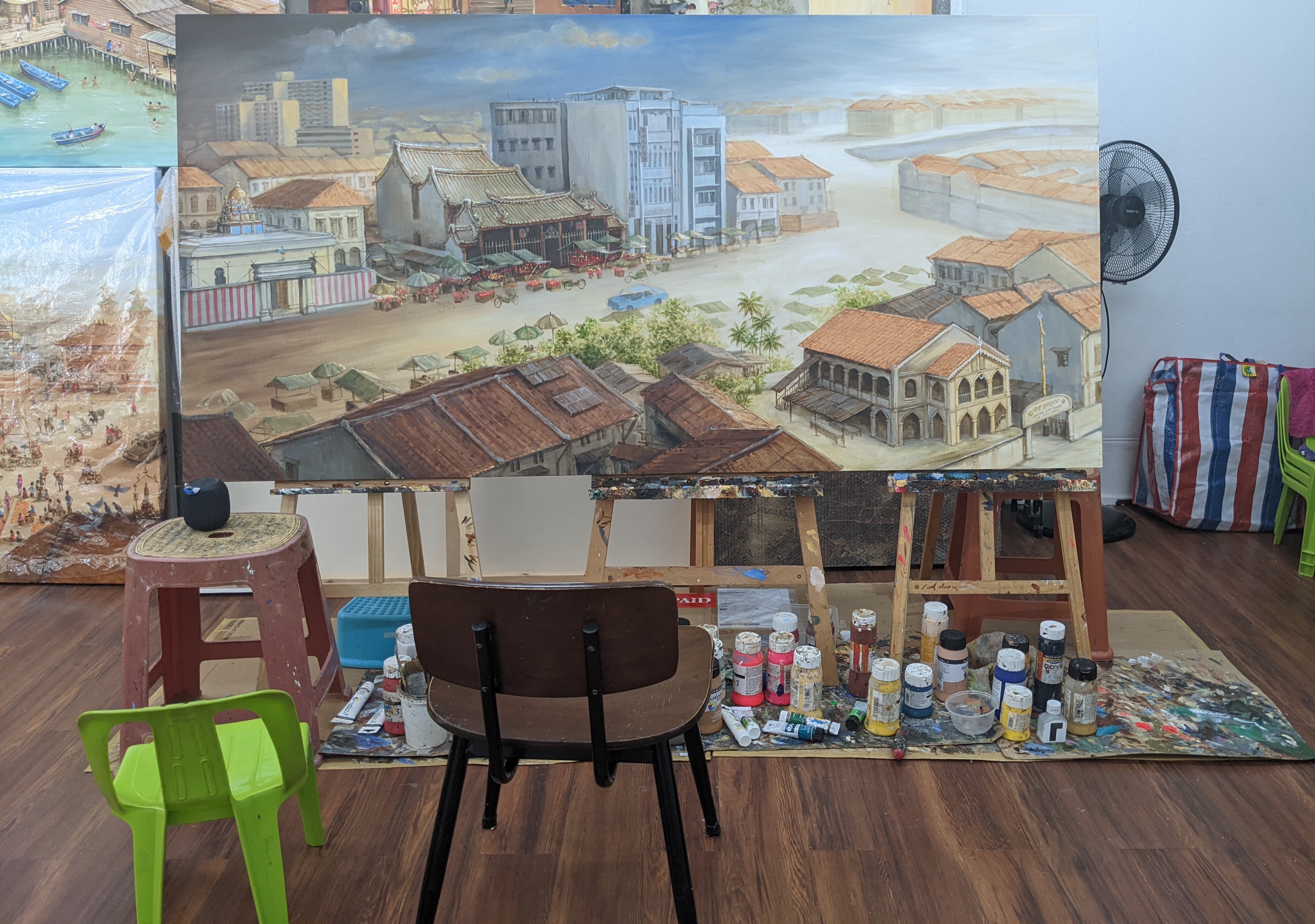 Photo by Kow Zishan
Photo by Kow Zishan
Stories of Us is a series about ordinary people in Singapore and the unique ways they’re living their lives. Be it breaking away from conventions, pursuing an atypical passion, or the struggles they are facing, these stories remind us both of our individual uniqueness and our collective humanity.
Top photo by Kow Zishan
If you like what you read, follow us on Facebook, Instagram, Twitter and Telegram to get the latest updates.
